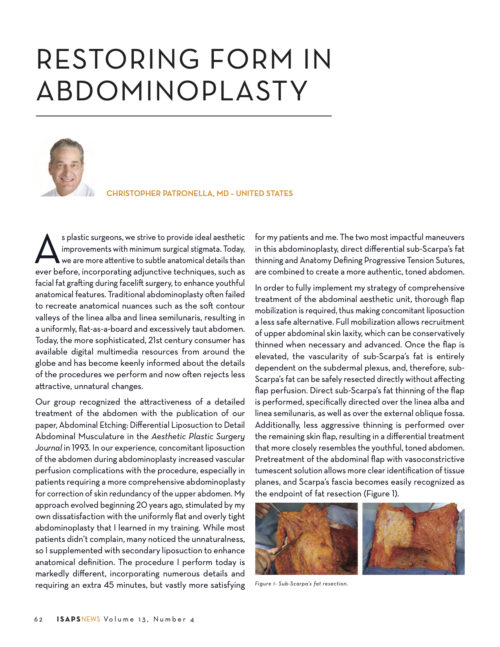Dr. Patronella's Articles
Articles by Dr. Patronella
Dr. Patronella’s articles describing his advanced surgical techniques have been published in the world’s premier plastic surgery publications, highlighted below. Explore these resources to learn more about the methods and philosophy behind his consistently excellent results.
“Safest Practices for Autologous Buttock Augmentation With Fat Grafting Using a Roller Pump Injection Technique” | Aesthetic Surgery Journal
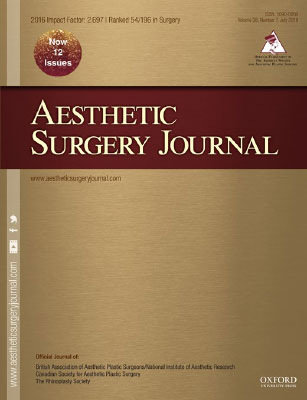
Dr. Patronella was invited to contribute to a study evaluating the safest, more reliable techniques for fat transfer buttock augmentation (Brazilian Butt Lift — BBL). This study used the roller pump injection technique, a variation that eliminates the need for manual graft preparation and injection.
Excerpt
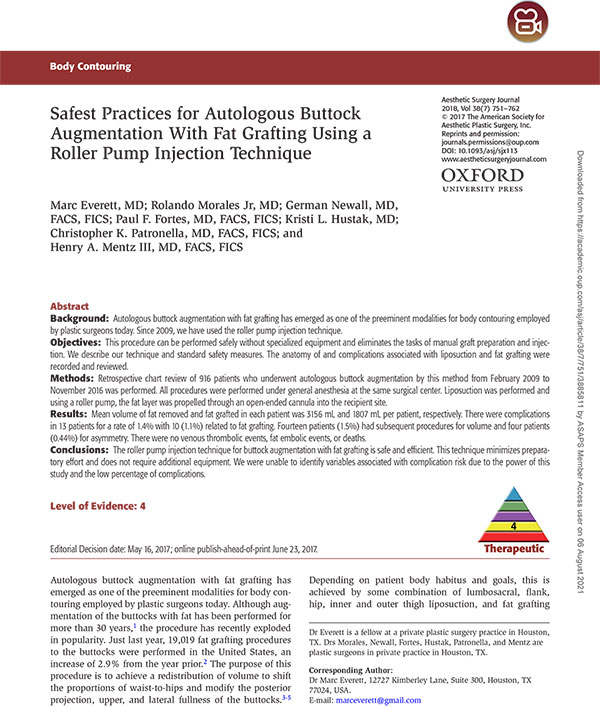
Our practice has seen a dramatic increase in the number of patients wishing for autologous buttock augmentation as well as an increase in the volume required to meet their goals. The roller pump injection technique has helped us to be able to meet this demand by facilitating large volume fat grafting in a way that is both rapid and safe. The setup for this method is completed in under a minute and can be performed at any time in the sterile field. The minimal manipulation required to prepare the graft also takes less than a minute and therefore does not occupy a surgical assistant during time under anesthesia for any longer than that.
Our dataset begins with the start of our experience with the roller pump injection technique. Since utilization of this method for all patients undergoing buttock augmentation with fat in 2009, we have gone from 58 cases in that first year to 178 this year with two months left remaining.
Figure 1 shows the overall trend of volume injected has steadily increased, starting with an average of 1290 mL total graft in 2009 up to 2004 mL total graft today. This mirrors the trends from the series published by CardenasCamarena et al6 in which they demonstrated the progression in their experience in different phases. There were no patients in their series that had more than 500 mL per buttock grafted in the initial phase of the study, and then by the time the accrual of their last phase had concluded, there was a considerable constituent with 501 to 1160 mL grafted per side. As demonstrated by the increase in the number of cases and average amount of graft volumes over the course of our experience, we affirm that there is an evolution in buttock aesthetics. Demands for higher volumes are influenced by the increasing awareness of the “Brazilian Butt Lift” from popular culture and through social media. At the time that this manuscript is being prepared, there are 157,652 hashtags for “BBL” and 39,998 for “Brazilian Butt Lift” on Instagram alone and 3,510,000 results on Google for the search “celebrity Brazilian Butt Lift.”
“Expanding the Progressive Tension Suture Concept: A Study of its Utility in Body Contouring Procedures” | Aesthetic Surgery Journal
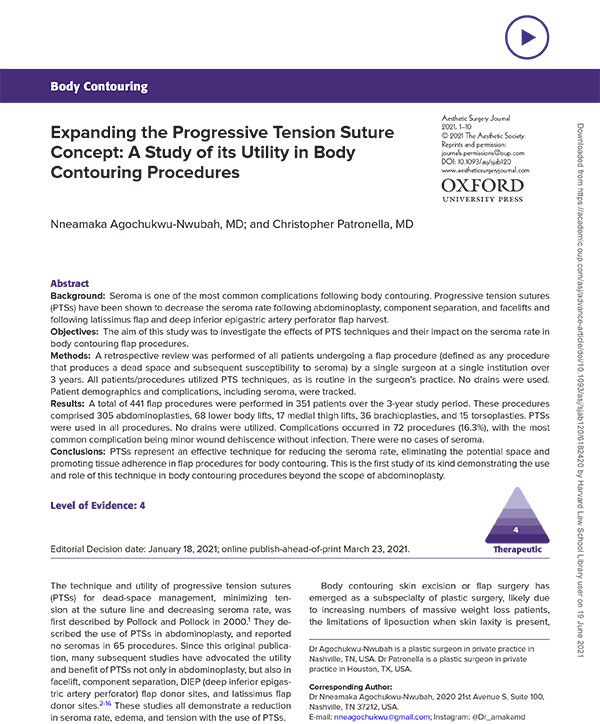
In a study for the Aesthetic Surgery Journal (2021, 1-10), Dr. Patronella was invited to contribute his work using progressive tension suturing (PTS) techniques in body contouring flap procedures as a way to reduce and limit seromas.
Excerpt
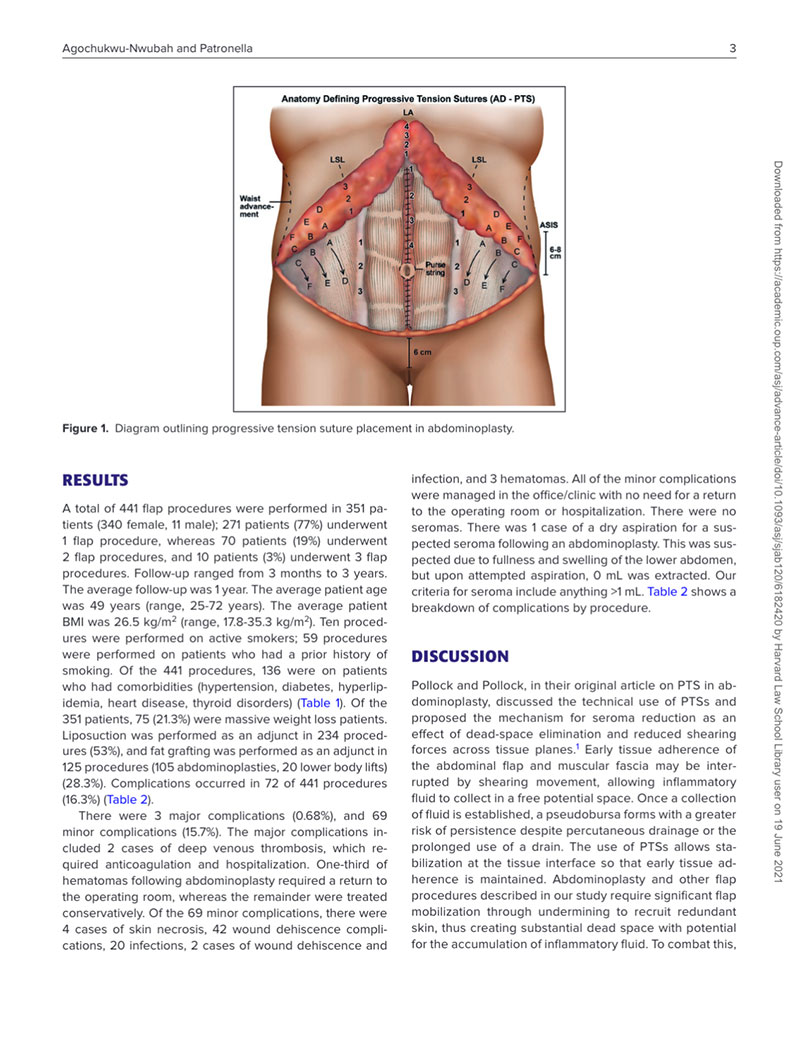
Pollock and Pollock, in their original article on PTS in abdominoplasty, discussed the technical use of PTSs and proposed the mechanism for seroma reduction as an effect of dead-space elimination and reduced shearing forces across tissue planes.1 Early tissue adherence of
the abdominal flap and muscular fascia may be interrupted by shearing movement, allowing inflammatory fluid to collect in a free potential space. Once a collection of fluid is established, a pseudobursa forms with a greater risk of persistence despite percutaneous drainage or the
prolonged use of a drain. The use of PTSs allows stabilization at the tissue interface so that early tissue adherence is maintained. Abdominoplasty and other flap procedures described in our study require significant flap mobilization through undermining to recruit redundant skin, thus creating substantial dead space with potential for the accumulation of inflammatory fluid. To combat this, drains, compression garments, and body casts have been proposed. However, these measures are temporary and do not completely eliminate or obliterate dead space, or prevent inflammatory fluid accumulation, and seroma rates remain high for each of these flap procedures. In 2016, Macias et al reviewed 451 abdominoplasties in 2 groups: (1) PTS and no drain vs (2) no PTS and with drains. A seroma rate of 2% was noted in the PTS and no-drain group, whereas a seroma rate of 9% was noted in the no-PTS and drain group.
"The True Form Tummy Tuck - A New Approach to Abdominoplasty" | Best-In-Class Surgeons
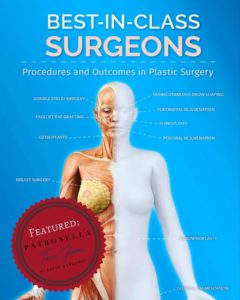 Dr. Patronella was invited to contribute a chapter about his True Form Tummy Tuck® approach to the Best-In-Class Surgeons book (2019), joining a select group of premier plastic surgeons around the world who co-authored the book.
Dr. Patronella was invited to contribute a chapter about his True Form Tummy Tuck® approach to the Best-In-Class Surgeons book (2019), joining a select group of premier plastic surgeons around the world who co-authored the book.
Excerpt
What are the key components of an abdominoplasty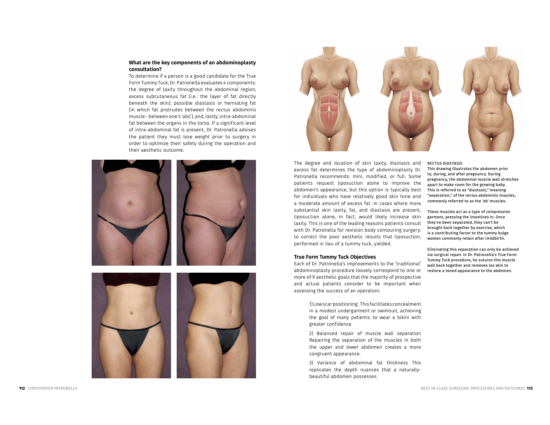 consultation?
consultation?
To determine if a person is a good candidate for the True Form Tummy Tuck, Dr. Patronella evaluates 4 components: the degree of laxity throughout the abdominal region; excess subcutaneous fat (i.e.: the layer of fat directly beneath the skin); possible diastasis or herniating fat (in which fat protrudes between the rectus abdominis muscle – between one’s ‘abs’), and, lastly, intra-abdominal fat between the organs in the torso. If a significant level of intra-abdominal fat is present, Dr. Patronella advises the patient they must lose weight prior to surgery in order to optimize their safety during the operation and their aesthetic outcome.
The degree and location of skin laxity, diastasis and excess fat determines the type of abdominoplasty Dr. Patronella recommends: mini, modified, or full. Some patients request liposuction alone to improve the abdomen’s appearance, but this option is typically best for individuals who have relatively good skin tone and a moderate amount of excess fat. In cases where more substantial skin laxity, fat, and diastasis are present, liposuction alone, in fact, would likely increase skin laxity. This is one of the leading reasons patients consult with Dr. Patronella for revision body contouring surgery: to correct the poor aesthetic results that liposuction, performed in lieu of a tummy tuck, yielded.
"Redefining Abdominoplasty Through 10 Key Refinements" | International Society Of Aesthetic Plastic Surgery News
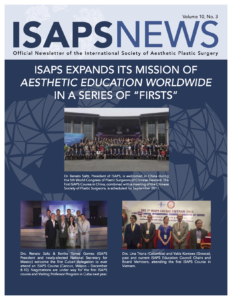
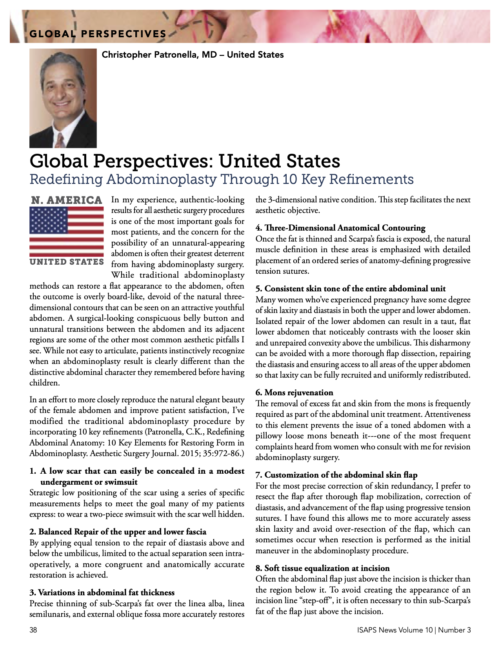 In an issue from the International Society Of Aesthetic Plastic Surgery News (Sept. – Dec. 2016) featuring abdominoplasty (tummy tuck) advances around the globe, Dr. Patronella’s True Form Tummy Tuck® was among those singled out for recognition.
In an issue from the International Society Of Aesthetic Plastic Surgery News (Sept. – Dec. 2016) featuring abdominoplasty (tummy tuck) advances around the globe, Dr. Patronella’s True Form Tummy Tuck® was among those singled out for recognition.
Excerpt
In my experience, authentic-looking results for all aesthetic surgery procedures is one of the most important goals for most patients, and the concern for the possibility of an unnatural-appearing abdomen is often their greatest deterrent from having abdominoplasty surgery.
While traditional abdominoplasty methods can restore a flat appearance to the abdomen, often the outcome is overly board-like, devoid of the natural three- dimensional contours that can be seen on an attractive youthful abdomen. A surgical-looking conspicuous belly button and unnatural transitions between the abdomen and its adjacent regions are some of the other most common aesthetic pitfalls I see. While not easy to articulate, patients instinctively recognize when an abdominoplasty result is clearly different than the distinctive abdominal character they remembered before having children.
In an effort to more closely reproduce the natural elegant beauty of the female abdomen and improve patient satisfaction, I’ve modified the traditional abdominoplasty procedure by incorporating 10 key refinements (Patronella, C.K., Redefining Abdominal Anatomy: 10 Key Elements for Restoring Form in Abdominoplasty. Aesthetic Surgery Journal. 2015; 35:972-86.)
"Redefining Abdominal Anatomy: 10 Key Elements for Restoring Form in Abdominoplasty" | Aesthetic Surgery Journal
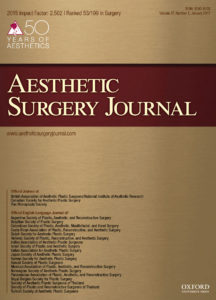
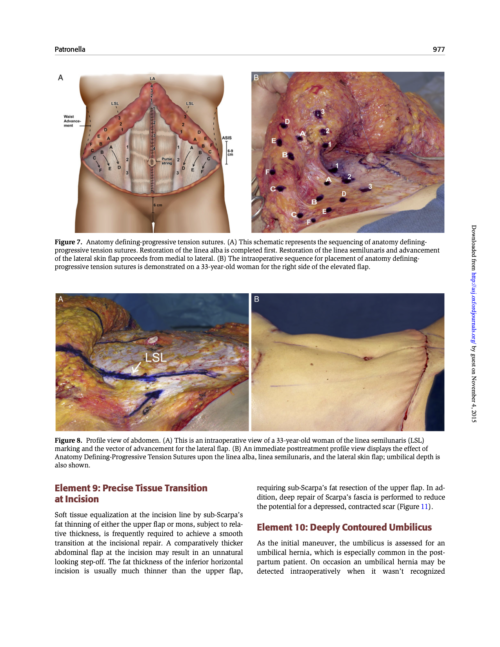 Dr. Patronella’s innovative abdominoplasty approach, the True Form Tummy Tuck®, was the “Featured Operative Technique” in the prestigious Aesthetic Surgery Journal (ASJ) in Nov./Dec. 2015. ASJ is a peer-reviewed international journal focusing on scientific developments and clinical techniques in aesthetic surgery.
Dr. Patronella’s innovative abdominoplasty approach, the True Form Tummy Tuck®, was the “Featured Operative Technique” in the prestigious Aesthetic Surgery Journal (ASJ) in Nov./Dec. 2015. ASJ is a peer-reviewed international journal focusing on scientific developments and clinical techniques in aesthetic surgery.
Excerpt
While traditional abdominoplasty methods can successfully achieve the objective of restoring a flat appearance, the results can be artificially board-like, lacking the subtle anatomical features of a three-dimensional abdomen, thus creating the potential for patient dissatisfaction. While often difficult to articulate, patient criticism is almost always distilled to the ubiquitous concern that the surgical abdomen lacks the natural features of an authentic, youthful abdomen. In an effort to provide a more anatomically accurate outcome and improve patient satisfaction, I have made a series of technical modifications to the abdominoplasty that I now perform. Ten key technical refinements, including a modified “Anatomy Defining” Progressive Tension Suture technique, were successively incorporated in 177 patients during the first 5 years of 2000-2014. All have been applied consistently in 961 abdominoplasty procedures during the subsequent 10 years, often accompanied by liposuction of adjacent lateral (non-abdominal) areas to ensure harmonious propor- tion. This series of refinements adds precision and detail by redefining the native anatomical nuances of the abdomen, an aesthetic objective that has been consistently achieved in BMI ranges between 20 and 35. Overall satisfaction with results was high (94%). The 10 elements described are safe, effective, and lasting.
"Restoring Form in Abdominoplasty" | International Society Of Aesthetic Plastic Surgery News
Dr. Patronella was invited to share his tummy tuck expertise in the ISAPS News (January – March 2020), which spotlighted the techniques of some of the world’s foremost abdominoplasty specialists.
Excerpt
As plastic surgeons, we strive to provide ideal aesthetic improvements with minimum surgical stigmata. Today, we are more attentive to subtle anatomical details than ever before, incorporating adjunctive techniques, such as facial fat grafting during facelift surgery, to enhance youthful anatomical features. Traditional abdominoplasty often failed to recreate anatomical nuances such as the soft contour valleys of the linea alba and linea semilunaris, resulting in a uniformly, flat-as-a-board and excessively taut abdomen. Today, the more sophisticated, 21st century consumer has available digital multimedia resources from around the globe and has become keenly informed about the details of the procedures we perform and now often rejects less attractive, unnatural changes.
My approach evolved beginning 20 years ago, stimulated by my own dissatisfaction with the uniformly flat and overly tight abdominoplasty that I learned in my training. While most patients didn’t complain, many noticed the unnaturalness, so I supplemented with secondary liposuction to enhance anatomical definition. The procedure I perform today is markedly different, incorporating numerous details and requiring an extra 45 minutes, but vastly more satisfying for my patients and I.


